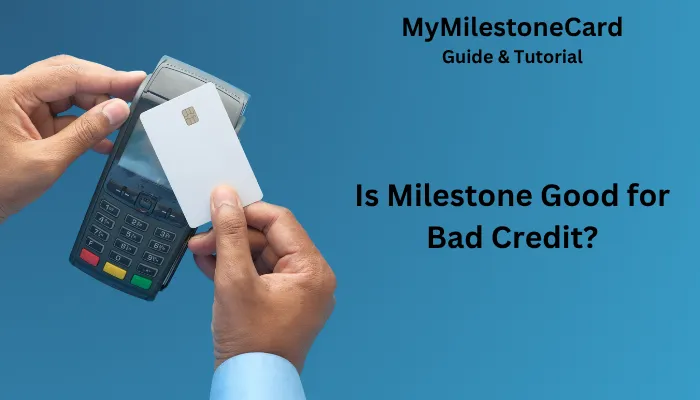I’ve navigated the choppy waters of bad credit, and I know how daunting it can be to find a credit card that works for you. When I stumbled upon the Milestone Credit Card, or MyMilestoneCard as it’s often called, I wondered, “Is Milestone good for bad credit?” After using it myself, I’m here to share my experience and guide you through whether this card is a solid choice for rebuilding your credit.
This blog dives deep into the card’s features, benefits, drawbacks, and alternatives, all from my perspective. Let’s explore if the Milestone Credit Card can help you rebuild your financial foundation. I’ll break it down with clear details, practical tips, and honest insights to help you decide if it’s the right move for your credit journey.

Why I Considered the Milestone Credit Card for Bad Credit
I needed a card that wouldn’t judge my past financial mistakes. The Milestone Credit Card caught my attention because it’s designed for people like me with less-than-perfect credit. Is Milestone good for bad credit? Let’s look at why I considered it.
My Initial Impressions
When I first explored the Milestone Credit Card, I liked that it’s an unsecured card, meaning I didn’t need to put down a security deposit. Many cards for bad credit require a deposit, which I didn’t have at the time.
The card, issued by The Bank of Missouri and serviced by Concora Credit, promised to report to all three major credit bureaus—Experian, Equifax, and TransUnion. I saw this as a chance to boost my credit score with responsible use.
Key Features That Stood Out
Here’s what I found appealing about the Milestone Credit Card:
- No Security Deposit: I didn’t need upfront cash, which was a relief.
- Credit Bureau Reporting: My on-time payments would show up on my credit reports.
- Pre-Qualification with Soft Pull: I could check my eligibility without hurting my credit score.
- Mastercard Network: I could use it anywhere Mastercard is accepted.
My Hesitations
But I had concerns. The card’s annual fee, ranging from $35 to $175 in the first year, felt steep. After the first year, it drops to $49, but a $12.50 monthly maintenance fee kicks in. I also noticed the credit limit, typically $300 to $700, was low, making it hard to keep my credit utilization below 30%.
I realized I needed to weigh these pros and cons carefully before deciding if this card was right for me. Let’s move on to break down the card’s benefits and drawbacks in detail to see if it truly helps with bad credit.
My Experience Using the Milestone Credit Card
I decided to give the Milestone Credit Card a try, and here’s how it went. Is Milestone good for bad credit? My experience sheds light on this question.
How I Used the Card
I used the card for small purchases, like groceries or a streaming subscription, and paid the balance off quickly. I learned that keeping my balance low and paying on time was key to improving my credit score. The card reported my payments to the bureaus, which I saw reflected in my credit report after a few months.
My Credit Score Progress
After six months of responsible use, my credit score crept up from 540 to 580. It wasn’t a huge jump, but it was progress. I made sure to:
- Pay my bill before the due date every month.
- Keep my balance under $90 on a $300 limit to maintain low credit utilization.
- Avoid cash advances due to their high 35.9% APR.
Challenges I Faced
The low credit limit was tough. With a $300 limit and a $75 annual fee, I only had $225 to work with. The high 24.90% APR meant carrying a balance would cost me a lot in interest. I also waited nearly a month for the card to arrive, and I got a bill before it even showed up!
Here’s a quick table summarizing my experience:
| Aspect | My Take |
|---|---|
| Credit Limit | $300–$700, but often $300, which felt restrictive. |
| Fees | $35–$175 first year, $49 after, plus $12.50 monthly fee after year one. |
| APR | 24.90% for purchases, 35.9% for cash advances—expensive if I carried a balance. |
| Credit Building | Helped my score improve slightly with consistent on-time payments. |
I learned that while the card helped, its limitations required careful management. Now, let’s compare it to other options to see how it stacks up for bad credit.
Comparing Milestone to Other Credit Cards for Bad Credit
I didn’t stop at the Milestone Credit Card. I explored other options to answer, “Is Milestone good for bad credit?” compared to alternatives.
Secured vs. Unsecured Cards
I looked at secured cards, which require a deposit but often have lower fees. For example, the Capital One Quicksilver Secured Cash Rewards Credit Card offers 1.5% cash back and no annual fee, but I needed a $200 deposit. The Milestone’s lack of a deposit was a plus, but its fees were higher.
Alternatives I Considered
Here are three cards I compared:
- Capital One Quicksilver Secured: No annual fee, 1.5% cash back, but requires a $200 deposit.
- Chase Freedom Rise: 1.5% cash back, no annual fee, but works best with a Chase account and $250 balance.
- Credit One Bank Platinum Visa: Offers cash back, but has a $39 annual fee and variable APR.
My Takeaway
The Milestone Card’s high fees and low limit made it less appealing than secured cards with rewards. If I could afford a deposit, a secured card might’ve been better. Here’s a comparison table:
| Card | Annual Fee | Deposit | Rewards | APR |
|---|---|---|---|---|
| Milestone Mastercard | $35–$175 | None | None | 24.90% |
| Capital One Quicksilver Secured | None | $200 | 1.5% cash back | 29.99% variable |
| Chase Freedom Rise | None | None (Chase account recommended) | 1.5% cash back | 26.99% variable |
I found that other cards offered better value if I could manage a deposit or qualify for them. Let’s dive into practical tips for using the Milestone Card effectively if you choose it.
Tips for Using the Milestone Credit Card
If you’re considering the Milestone Credit Card, here’s how I made it work for me. Is Milestone good for bad credit? It can be, with these strategies.
My Strategies for Success
I followed these steps to maximize the card’s benefits:
- Pay on Time, Every Time: I set reminders to pay before the due date to avoid late fees and boost my credit.
- Keep Utilization Low: I used less than 30% of my limit ($90 on a $300 limit) to improve my score.
- Avoid Carrying a Balance: The 24.90% APR is high, so I paid off purchases immediately.
- Monitor My Credit: I checked my credit reports to ensure payments were reported correctly.
Mistakes I Avoided
I steered clear of cash advances due to their 35.9% APR and didn’t rely on the card for big purchases. I also contacted customer service promptly if I had issues, like delayed card delivery.
These tips helped me use the card as a stepping stone to better credit. Let’s wrap up with my final thoughts on whether the Milestone Card is worth it.
Conclusion
I’ve shared my journey with the Milestone Credit Card, and now it’s time to answer the big question: Is Milestone good for bad credit? For me, it was a mixed bag. The card helped me rebuild my credit without a deposit, but its high fees, low limit, and lack of rewards made it less appealing than alternatives.
If you’re in a pinch and can’t afford a deposit, it’s a decent start, but I recommend exploring secured cards for better value. Use MyMilestoneCard wisely, and it can be a small step toward financial recovery.
